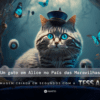
Introduction
Well-structured Facebook audiences can bring more results than you might think. They can, in just 3 months, increase a company's conversion value via Facebook Ads by more than 500%, for example.
In this article, we will explore a case in which this was the result and talk about how this increase was achieved through Custom Audience Optimization. Follow along!
The Potential of Facebook
Facebook is one of the most widely used social networks today. According to Statista, the network has around 1.6 billion daily active users, making it an almost direct channel for connecting company and customer.
For this and many other reasons, the way you handle Facebook ads can be crucial to your company's success in terms of sales and brand recognition. And for good results, choosing who will be impacted by each of your ads through the Custom Audiences feature can be the golden key to your success on the platform.
Customized audiences
Facebook's Custom Audience is a great resource for any company. This is because it allows you to choose the users with the highest conversion potential to be impacted by your ads.
You can do this by choosing audiences with interests related to your business. For example, if you run a university book store, you could target your ads with an intersection of audiences.
So it's possible that only university students with an interest in books and reading will be impacted. This forms an overlap of 3 audiences (university students, those interested in books and those interested in reading), which brings people closer to you who are more qualified to buy.
The KV case
KV (a fictitious name to de-characterize the company) is a company in the underwear sector, with investments of between 3 and 5 thousand. It has products for maternity, post-surgery, plus size, etc.
Despite performing well in Facebook Ads campaigns, KV had room to grow. Given that the structure of the account was made up of just one campaign of interest, i.e. top of funnel, with generic and mixed audiences.
What's more, the account didn't have very well-defined target audiences, advertising products to users who most likely had no interest in them.
Identifying the problems with the public structure used
This structure implies a major problem. To solve it, let's think about the campaign structure and the audiences used?
Do you think that a pregnant woman and a post-surgical woman have the same purchasing interests? Probably not, right? While one needs a shaping belt, for example, a pregnant woman can't use the same product.
In a superficial separation of audiences, the two would probably be included in the same set of ads. They are the same sex, probably the same age and interested in women's fashion.
Now, imagine a person who came to your site, chose a product, reached the cart and didn't complete the purchase. Then think of a person who has never heard of your brand. Do you think the two are equally likely to buy? I don't think so either, do you? If we don't separate the audiences correctly, these two personas are impacted by the same ad, which isn't very smart.
That was KV's scenario. Despite having products targeting different audiences, the account only had one campaign whose audience was generic and encompassed all profiles at the same time. If the account still had good results, with good audience segmentation and structuring they only tended to increase. And it was no different!
How we improved the Custom Audience Structure
First, we separate the products sold by the client and analyze which audience is most appropriate for each of the categories. For example, people interested in plastic surgery would be a good audience for the post-surgical products category. Or, female people who are interested in maternity issues are an excellent audience for KV's maternity products.
Once this is done, we create a set of ads for each of the audiences. Consequently, in each of the ad sets we only advertise products of interest to each audience.
In this way, male products were no longer advertised to women, for example. As a result, the chances of conversion increased, since only people with a product profile were impacted by them.
Finally, we structure a sales funnel in the account. In other words, we separate the ad sets into interest, action and decision groups. Decision users already know your brand, they know which product they want to buy, they've already visited your website.
On the other hand, users of interest have a very generic vision of the product they want and are not sure if they want to buy from your brand. It is therefore interesting that the advertising strategy for each of these users is differentiated according to the moment of purchase they are in.
Let's look at some examples of the actions that have been taken.
Audience 1: Interest in Maternity Products
For a better understanding, let's look at it visually. For the maternity products ad set, we've created an audience that includes a range of interests. These include the following:
In other words, people with an interest in these points, among others, would be impacted by the ad. Let's explain two of them a little better:
- Pregnancy: The choice was simple. The products are for pregnant women, so people with an interest in pregnancy are very qualified for the product.
- Johnson's Baby: The idea was based on taking products that the persona in question uses. In this case, pregnant women are consumers of children's products and a specific brand for this is Johnson's Baby.
Audience 2: Interest in post-operative products
For the other audience, the promotion of post-operative products, we created a set of ads with an interest in plastic surgery. See examples of interest created for this case:
- Silicone: People interested in silicone are people interested in plastic surgery. As our products are aimed at people in the post-operative period, it makes sense for this type of person to be included in our audience.
- Belvivere Plastic Surgery: Similar to the previous case, here we have a plastic surgery center. People with an interest in this center are likely to be interested in plastic surgery. And that, consequently, they are a qualified audience for post-operative products.
In other words, only people with an interest in silicone, plastic surgery, etc. will be impacted by post-operative products. Which is a much more qualified audience, wouldn't you agree?
In the previous examples, we mixed more generic interests (such as Pregnancy or Silicone) with more specific interests (such as Johnson's Baby).
This mix is very important for controlling the size of the audience. That way, it won't be too broad or too specific.
Audience 3: Lookalike buyers
In addition, we structured a sales funnel in which audiences of interest, action and decision were established.
An example of an audience of interest is the Lookalike audience. Take a look at this audience here:
This set of ads was created for the 1% of Facebook users who have similar characteristics to those who have bought from the store in the last 180 days. Are you confused? Let's break it down!
By tracking the site, we can identify which users have bought from KV's online store in the last 180 days. Facebook Ads can analyze this audience and find other users who have similar behavior but are not customers. We then took 1% of these users and created a specific audience.
You might ask yourself: but only 1%? Even though it's a very small percentage, the audience in the example has a potential reach of 1,000,000 people. Quite a lot of people, isn't it?
With a segmented structure in line with the client's products, the account was optimized and the results came in.
Results Obtained with Custom Audience Optimization
After the adjustments, we achieved good results in just three months.
Facebook Ads revenue grew, bringing a 120% increase in overall e-commerce revenue. We also managed to increase the account's ROAS (return on investment) by 5%.
All this following the strategy of well-defined and specific audiences for each product category.
If we look at the graph below, we can see the evolution of the conversion value of purchases on the site.
In light blue, we have the figures from April 30 to August 1. In dark blue, we have the figures from August 1st to November 1st, precisely the period after the restructuring of the account. It's clear to see that performance has increased by more than 500%.
We can also look at the number of purchases on the site and the cost they generate:
In blue and light green we have the number of purchases and the cost, respectively, before the adjustment. In the darker shades, we have the performance after the adjustments.
It is notable that the number of purchases through Facebook Ads has grown by around 500%, while the cost per purchase on the site has remained practically constant, growing by around 100%.
Although the action seemed simple, KV leveraged it and greatly increased its sales. Would you like to learn more about Facebook Ads?
Click here to read an article we've prepared about another case of Facebook campaign acceleration!




















